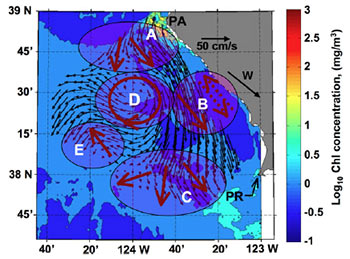 Physical coastal oceanography research at BML focuses on ocean upwelling, land runoff, and the connections between coastal estuaries (both small and large) and the ocean. Coastal oceanography at the land-sea interface is a unique niche in oceanography and there is little doubt that the Coastal Oceanography Group (COG), led by John Largier, is highly productive at both regional and national/international levels. The Coastal Oceanography Group focuses on regional place-based research along the north coast of California, taking advantage of the unique ocean upwelling zone, as well as in comparable regions globally. With new as well as continued collaborations with biologists and modelers, and with diverse funding for this research, the COG has made a major impact on our understanding of coastal processes at both the basic physical oceanography level as well as the applied coastal management level.
Physical coastal oceanography research at BML focuses on ocean upwelling, land runoff, and the connections between coastal estuaries (both small and large) and the ocean. Coastal oceanography at the land-sea interface is a unique niche in oceanography and there is little doubt that the Coastal Oceanography Group (COG), led by John Largier, is highly productive at both regional and national/international levels. The Coastal Oceanography Group focuses on regional place-based research along the north coast of California, taking advantage of the unique ocean upwelling zone, as well as in comparable regions globally. With new as well as continued collaborations with biologists and modelers, and with diverse funding for this research, the COG has made a major impact on our understanding of coastal processes at both the basic physical oceanography level as well as the applied coastal management level.
The Bodega Marine Laboratory's Coastal Oceanography Program is directed at the emerging discipline of "environmental oceanography," in which oceanographic study, analysis and insight is directed at resolving environmental issues that are critical to the sustainable interaction between human society and our planet. The ocean off BML is renowned for strong winds that draw cold nutrient-rich water up to sunlit ocean surfaces and support one of the earth's most productive marine ecosystems. BML scientists examine how oceanographic and atmospheric processes shape the environment and influence the distribution and growth of marine organisms along the coast. Studies address marine fisheries, atmospheric processes, Marine Protected Areas, carbon and nitrogen cycles, land runoff and water quality in coastal waters. This research utilizes BML's environmental sensor network, the Bodega Ocean Observing Node (BOON), and state-of-the-art research vessel, the R/V Mussel Point.

